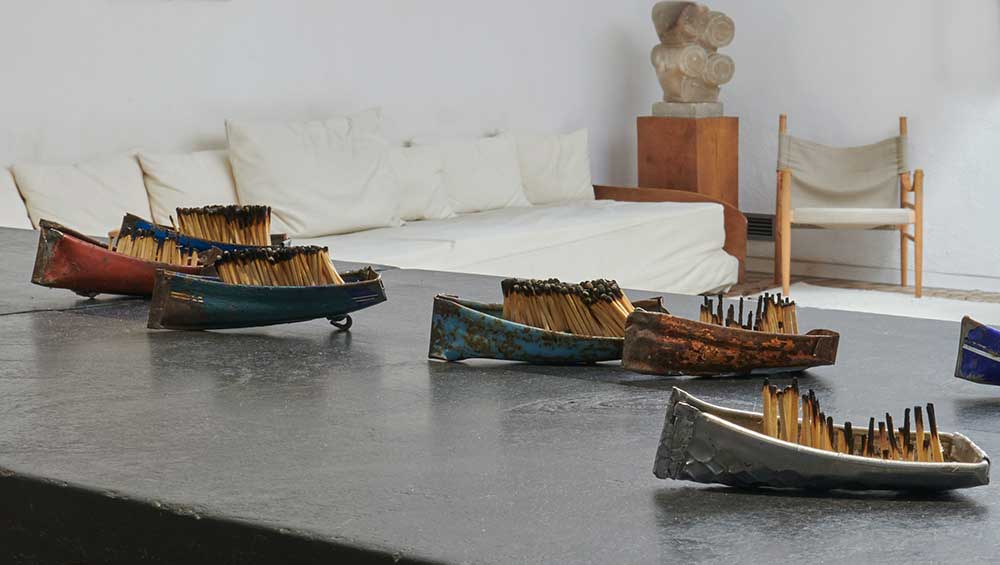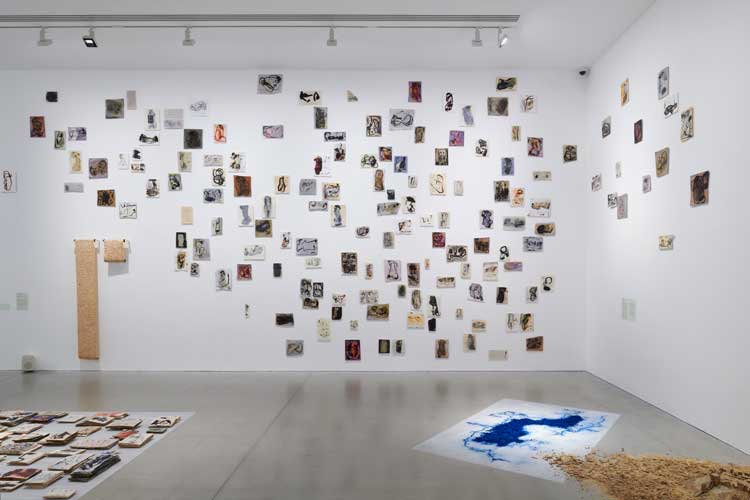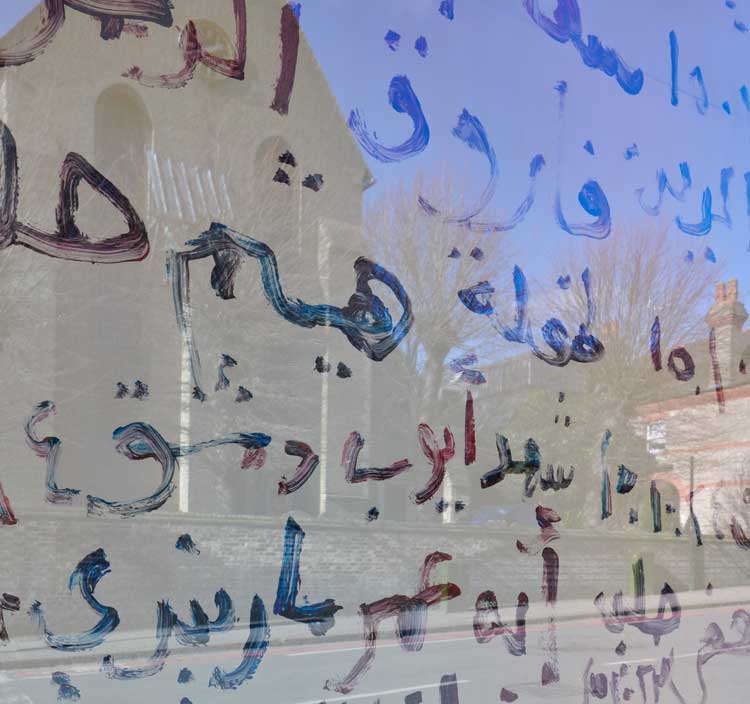
Issam Kourbaj: Urgent Archive, installation view, Kettle’s Yard, Cambridge, 2 March – 26 May 2024.
Kettle’s Yard, Cambridge
2 March – 26 May 2024
by BETH WILLIAMSON
Born in Syria in 1963, Issam Kourbaj trained at the Institute of Fine Arts in Damascus, Repin Institute of Fine Arts & Architecture in Leningrad (now Saint Petersburg) and Wimbledon School of Art in London. He has lived and worked in Cambridge since 1990. Kettle’s Yard is somewhere the artist says he feels at home and that is clear in this exhibition, even though it is rooted in Syria and Kourbaj’s response to the Syrian uprising, begun in March 2011. Thirteen years on, the artist continues to feel a strong responsibility to respond to and somehow record events in Syria through his practice, to highlight the trauma and conditions that the Syrian people continue to face.

Issam Kourbaj: Urgent Archive, installation view, Kettle’s Yard, Cambridge, 2 March – 26 May 2024.
Despite the height and span of the galleries at Kettle’s Yard, Kourbaj’s work occupies their spaces lightly, often as if hung or placed in an intimate domestic environment. In his collecting, ordering and reordering of found materials, the artist performs repeated daily archival acts. These actions interrogate the possibility that art might help us to better understand traumatic events historically and personally. While Kourbaj’s work feels intensely personal, it undoubtedly engages with the wider historical sweep of events in Syria.
-copy.jpg)
Issam Kourbaj, Urgent archives, written in blood, 2019. Photo: This Is Photography. Courtesy the artist.
The exhibition takes its title from the work Urgent Archives, Written in Blood (2019), which is displayed in the centre of one gallery space. It references political prisoners in Syria whose names were written in blood and smuggled out in the shirt seams of the journalist Mansour Omari when he was released. Rather than reproducing the names of these prisoners, Kourbaj instead makes gestural marks, drawing over the open pages of found books, defacing, redacting and so disrupting the flow of information. The title also gestures to the sheer individual effort necessary by the artist to sustain his protracted efforts. It is an immense commitment from Kourbaj, who has been unable to visit Syria since 2007.
.jpg)
Issam Kourbaj, Killed, detained and missing (women), 2019. Ink on Pianola scrolls. Photo: This Is Photography. Courtesy the artist.
Killed, Detained and Missing (Women) (2019) is a quiet work, sombre in tone, that consists of ink on found piano scrolls and an audio recording. The scroll contains a musical score to be played automatically on a pianola. Kourbaj said: “When I saw the scrolls, I thought, these are silenced. The silenced technology has gone. It’s collapsed. This is what has happened to these women.” Acting to somehow correct this silence, Kourbaj has written the names of women killed, detained or missing in Syria. In the accompanying audio, each name is recited aloud. Kourbaj has also expanded this particular iteration of the work by writing additional names on the gallery windows outside on Castle Street. In this way, the work acts as a memorial to these women, but also as a prompt to viewers, and indeed passersby, to remember them not as a faceless growing group, but as named individuals.

Issam Kourbaj: Urgent Archive, installation view, Kettle’s Yard, Cambridge, 2 March – 26 May 2024.
One of the themes that runs through the exhibition is the artist’s preoccupation with seeds and the impact of war on agriculture and food production, as well as the natural world more broadly. In Our Exile Grows a Day Longer and a Day Closer Is Our Return (2024), a damaged tent is threaded with date stones, marking one of the 4,750 days since the Syrian uprising. Kourbaj’s concern is for the seed as a repository of information, an archive in its own right. In 2015, the national seed bank in Aleppo was bombed, requiring the first withdrawal from the Global Seed Vault on Spitsbergen, part of Norway’s Svalbard archipelago (which holds duplicates of 1,214,827 seed samples), in order to preserve ancient crops of the Fertile Crescent region of the Middle East. Kourbaj’s deep interest in seeds is extended through his collaboration with researchers at the University of Cambridge to study Syrian wheat seeds that have been burned. Using powerful microscopy to zoom in, the artist photographs the burnt seeds on a huge scale. Estranged from their normal small size, the damaged surface of the seeds takes on a waxy, bodily appearance – Is It from a Grain of Wheat That the Dawn of Life Bursts Out … and Also the Dawn of War? (2023-24). In another work, Unknown: Roots and Shoots (2022), Kourbaj makes a film projection of dried out seeds that then feature in a video work Despite the Fall (2023), documenting wheat seeds as they germinate and grow roots and shoots.
.jpg)
Issam Kourbaj. Date seeds. Photo: This Is Photography. Courtesy the artist.
Seeds often seem to have the ability to take root and thrive wherever they have the slightest opportunity and Kourbaj has provided opportunities here. He has planted Syrian wheat outside Kettle’s Yard where it will be harvested and made into bread as part of this exhibition. With support from Cambridge University Botanic Garden and the Royal Botanic Gardens, Kew, this is a truly collaborative effort where art and science can happily come together. The idea of growing a small crop of Syrian wheat in the context of this exhibition is surely an act of radical hope for a better future, a flourishing, even.
-copy.jpg)
Issam Kourbaj, Leave to Remain A Single Syrian grain, airborne, 2020. Written on the back of used stamps (single lines in English), 366 stamps, one per day/line. Photo: This Is Photography. Courtesy the artist.
Aleppo soap features in the exhibition, too, and, as the writer and critic Bonnie Greer rightly notes, it is a reminder that we cannot wash our hands of what is happening in Syria, our common humanity. Within the house at Kettle’s Yard sits Kourbaj’s Dark Water, Burning World (2016), a fleet of tiny boats made from bicycle mudguards and populated with burnt matchsticks that indicate people huddled together in fear. Just as we cannot wash our hands of Syrian strife, nor can we forget the thousands of refugees huddled in often unsafe vessels on a dangerous sea.
Kourbaj’s bringing together of art, science and politics creates hugely affective work that simply cannot be ignored. The sensitive and thoughtful works in this exhibition are deeply emotive and melancholic in their address of the artist’s homeland and its destruction. Yet in his persistence, his relentless archiving, sketching and making, comes a glimmer of hope that the world could be somehow different. Kourbaj keeps making, does not relent and does not yield. His work conveys a sense of courage and a strength of commitment that, at best, opens up the potential for change for the better and, at the very least, underlines the stories of lives lost and traumatised so that they are not forgotten. They must not be forgotten, which is why Kourbaj continues to witness.
• A concurrent exhibition, Issam Kourbaj: You Are Not You and Home Is Not Home is at the Heong Gallery, Downing College, Cambridge, until 26 May 2024.